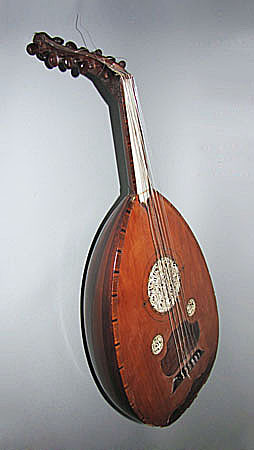
Owner: HWMC
Catalog#: ME-CHLT-02-14
Lutes
Turkey/Greek 'Oud' (Outi)
Turkey/Greece
Arabs
Wood, steel strings, bone
Early-Mid 20th century
Length: 33.5 in, Width: 14 in
Chordophones – Lutes
The ud (oud) is a short-necked plucked lute from the Arabic world, used in North Africa, Palestine, Lebanon, Jordan, Syria, Iraq, the Arabian Peninsula, and Iran. (The Arabic spelling for this instrument is ud) It is also believed to be the ancestor of the European lute. The classical ud (oud) of the Arabs, consists of a large pear-shaped soundbox formed from 16-21 ribs (strips) of wood glued together with a soundboard made of soft wood that has one or (most often) three rosettes. Models include a five-course (10 strings); six-course (12 strings, or 5 pairs and 1 low string), and seven-course (6 pairs and 1 low string). The fretless fingerboard is flush with the sound board and the pegs are inserted from both sides of an open pegbox, which is bent at an angle backwards at the top end of the fingerboard. Depending on the regional characteristics of the ud (oud), the tuning, number of strings, size, and shape differs from each other.
This Turkish/Greek style oud has three sound holes adorned with rosettes, that are slightly smaller than the Arabic uds (ouds). The fingerboard and soundboard are flush and where the fingerboard joins the soundboard, there is a small ornament that looks like an extension of the fingerboard that joins to a point. While most Turkish ouds are usually quite plain, this oud has a white bone fingerboard with a scratch plate of darker wood between the lower two small sound holes. The Turkish oud soundboard is usually left unvarnished, but this oud is varnished and there is wood inlaid trimming around the edges. All of these alterations to the Turkish oud, possibly makes this oud from Greece, where it is called the outi. The tuning of the Turkish/Greek style oud with 11 nylon strings, is two notes higher than the Arabian oud : E AA BB ee aa d’d’.
